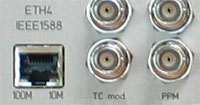PTP IEEE 1588
The Precision Time Protocol (PTP)
Where is sub-μs Accuracy required?
- Automation and control systems
- Measurement and automatic test systems
- Power generation, transmission and distribution systems
- Ranging, telemetry and navigation
- Telecommunications
 The Institute of Embedded Systems (InES) of the University of Winterthur is addressing the practical implementation and application of PTP. MEINBERG developed a PTP capable timeserver in cooperation with InES.
The Institute of Embedded Systems (InES) of the University of Winterthur is addressing the practical implementation and application of PTP. MEINBERG developed a PTP capable timeserver in cooperation with InES.
Additional the Institute of Embedded Systems offers PTP software, PTP hardware, training and support.
IEEE 1588
The objective of IEEE 1588 is defined in the 'Scope' section of the Project Authorization Request approved by the Standard Board of the IEEE as follows.
"This standard defines a protocol enabling precise synchronization of clocks in measurement and control systems implemented with technologies such as network communication, local computing and distributed objects. The protocol will be applicable to systems communicating by local area networks supporting multicast messaging including but not limited to Ethernet. The protocol will enable heterogeneous systems that include clocks of various inherent precision, resolution and stability to synchronize. The protocol will support system-wide synchronization accuracy in the sub-microsecond range with minimal network and local clock computing resources. The default behavior of the protocol will allow simple systems to be installed and operated without requiring the administrative attention of users."
- The IEEE 1588 standard defines a protocol enabling precise synchronization of clocks in measurement and control systems implemented with technologies such as network communication, local computing and distributed objects.
- The IEEE 1588 protocol will enable heterogeneous systems that include clocks of various inherent precision, resolution and stability to synchronize.
- The protocol supports synchronization accuracy in the sub-microsecond range with minimal network and local clock computing resources.
- PTP / NTP Time Signal Converter

SyncBox N2X - PTP / NTP Time Signal Converter


